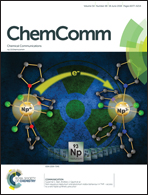Transfer hydrogenation of carbon dioxide and bicarbonate from glycerol under aqueous conditions†
Abstract
The transfer hydrogenation of CO2 from glycerol to afford formic and lactic acid is a highly attractive path to valorizing two waste streams and is a significantly more thermodynamically favorable process than direct CO2 hydrogenation. We report the first homogeneous catalyst for this transformation consisting of a water-soluble Ru N-heterocyclic carbene complex. The catalyst affords lactic and formic acid selectively in the presence of a base at temperatures between 150 and 225 °C. Carbonate salts can also be utilized in place of CO2, affording the same products at higher rates.

- This article is part of the themed collection: Celebrating Excellence in Research: 100 Women of Chemistry


 Please wait while we load your content...
Please wait while we load your content...
